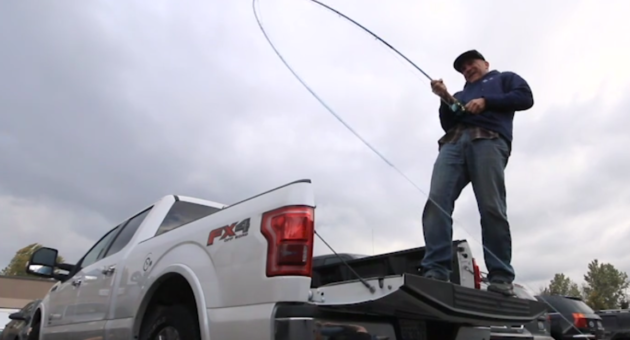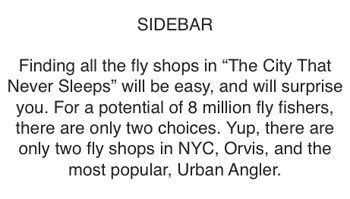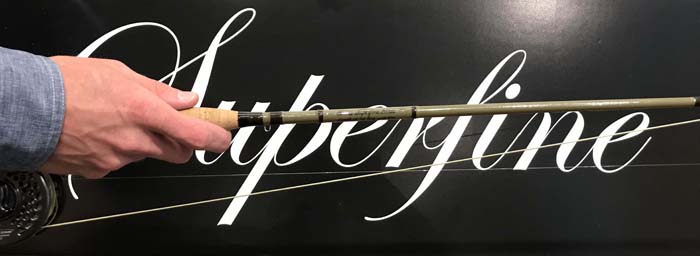
Carter Ross, Orvis’ Alpaharetta, Georgia, store’s Fishing Lead shows off the glass Superfine 4-weight that I got to test drive. The rod got an A+ and the driver was, reluctantly, awarded a license. Photo by Orvis’ Nick Dudash.
by Skip Clement
[dropcap]M[/dropcap]achines do not make fly rods, and fly rods are not assembled one series of parts harnessed to the next on a conveying production line. But fly rods are built to modern engineering standards relying on thousandths of an inch and grams as measurement guidelines to assure consistency and promised performance outcomes.
Fly rods are put together by craftspeople who scrutinize, touch, feel, measure, cut, apply coatings and bonding adhesives, test, and wrap each product. The rods by weight are not “almost alike,” they are mirror images, all of them. Monday’s 7-weight is the same as next month’s Monday 7-weight and so on.
But there is a negative with a single craftsperson being the chief cook and bottle washer, rod designer, and rod builder of your new fly rod. It’s a down the road problem and a sooner or later issue for most small rod building companies – especially those with single majordomo’s.
When the chief craftsperson, usually the owner, leaves the building, even for a two week holiday, the company could be out-of-service, disabled, unable to take a new order, deal with a change order, start or finish a repair, or answer a customer’s technical questions.
Full Flex, wind, big bushy flies, or just heavy flies and your thinking UH, OH because it’s glass
Maybe you’re overreacting! It doesn’t always have to be UH, OH – some rod designers already figured out how to lessen that to a degree never before realized.
It is argued that full flexing rods, and all are not just glass, become a tougher to cast in the wind or with a lead eye, big streamer, or an articulated fly than their kin in graphite, but the reality of it is that wind and heavy flies can offer up objections on any “type” of fly rod.
In the Florida Keys and Bahamas in the winter, cold fronts roll in one after the other – some days end up being nogo, and some days you wished you’d stayed put. Many other destinations have wind issues and the need for get down deep flies.
Blowing a constant 15 has escape routes, positions that even offer wind advantages. More than 20 – go home. And some days in these coordinates, a NW blow turns to W blow in 20 minutes and so a day goes. Point is, how many rods can you afford, how many rods can you fly to a destination with to deal with everything?
Thinking comfortable to cast all day should light your fire.
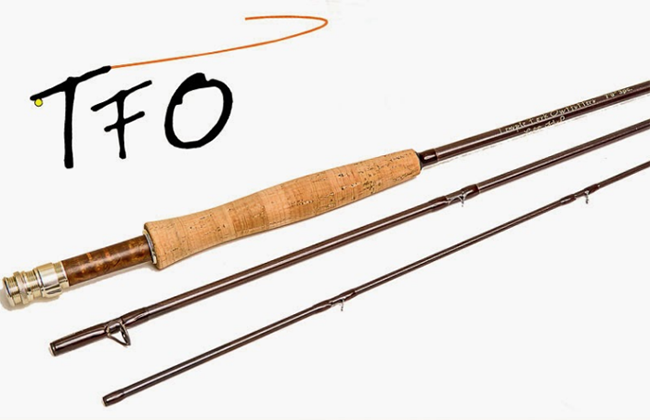
TFO’s Finesse Glass comes in nine flavors from .5-weight to 5-weight – Medium Action Freshwater fly rods.
Choosing a larger company as opposed to a small business or individual craftsperson to build your dream glass fly rod has some surprises waiting for
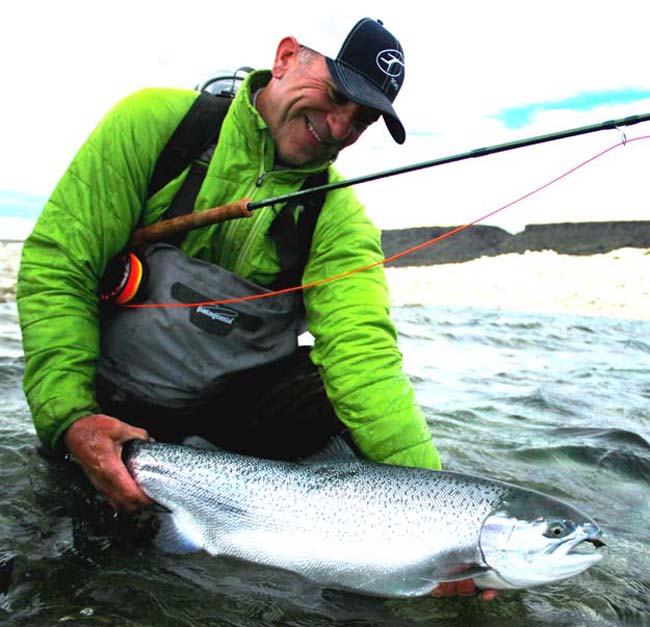
Glass without borders or boundaries. Master angler Tim Rajeff / Echo Fly Fishing, Vancouver, Washington, lands a monster rainbow in Strobel Lake, Argentina. Single-handedly, Tim Rajeff has put fiberglass fly rods in a League of Their Own, a quintessential Manifesto guy. Photo Tim Rajeff.
So, going glass by finding Mr. Goodbar Company – expert at building glass fly rods requires hitting the computer and take a look at what’s available from companies like Scott, Winston, Echo, Thomas & Thomas, Loomis, TFO, and Sage. But to your astonishment, you find that these big league companies only dabble in glass fly rods, or don’t bother with them at all. There is one exception, Echo.
But, then again, if you’re interested in a specific type of single-use fiberglass rod, you might find what you’re looking for if you’re willing to dig for that niche-need stick. For example, if you’re a died in the wool T&T fan and wanted a Thomas & Thomas glass rod, your choices would be limited to three rods, a 3-, 4-, and 5-weight selection brand named “Lotic.” All comfortably under 8-feet with the 3-weight, a pocket-sized 6’ 10”. These Lotic rods are beautiful and typical T&T examples of workmanship – stunning. They cost a whopping $600 each and they are most definitely just one trick ponies.
So, what’s a fly fisher to do in pursuit of a glass fly rod?
Now it’s back to the computer to do research online and make calls – ask the man or woman who owns one. The best idea would be to talk to your local fly shop. Another, wait for a Fly Fishing Show near you in the winter, attend the IFTD Industry Show in July (Denver 2019), plan on traveling to a regional fly fishing show, or go to a nearby fly shop hosting a fly fishing expo.
Let’s think Echo. Tim Rajeff’s Echo Fly Fishing is well worth mentioning
However, accessing Echo’s rods throughout the US and Canada can be trying, especially so if glass is on your mind, and that’s only due to the limited number of fly shops that would carry all their fiberglass fly rods, or any, if not a dealer.

GLASS TWO-HAND & SWITCH

BAD ASS GLASS
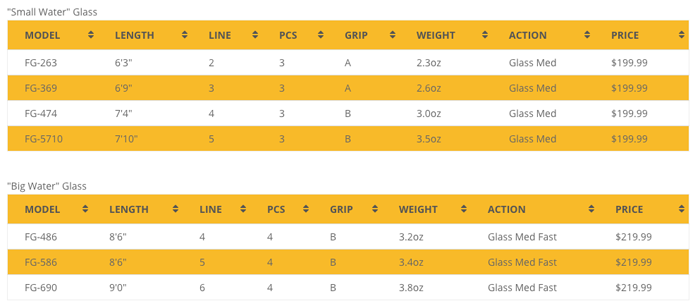
SMALL WATER GLASS and BIG WATER GLASS

BAD ASS GLASS QUICKSHOT
What about Orvis?
The one other need to check out fiberglass fly rods is Orvis, specifically an Orvis owned and operated store, and in some cases an authorized Orvis dealer. There, in an “Orvis owned store” you will find every fly rod they make – not perhaps the whole series, but at least an example of what you’re looking for in an action or price range, if not every rod in a series. Always waiting just for you to test drive in a parking lot of your choosing – out front or in the back.
Orvis’ Superfine fly rods are available in graphite and glass. The graphite and Superfine glass rods have the performance distinctions that graphite and glass inherently pass on, graphite is lighter, glass bending all the way to a stouter butt. The Superfine moniker is perfect for what these rods are said to be designed for. That would be small to medium riverine service, delicate casts inside 40-feet with dry flies the ideal foil.
However, don’t believe that those ascribed limits are Veritas, they perform flawlessly in bigger waters that yield bigger fish that can be managed.

Orvis Superfine Glass rods. Orvis image.
Review
Orvis does not advertise that it built the Superfine Glass fly rod for more significant animals than trouts. I think that’s a big mistake. Trout anglers speak about the Superfine glass rods as if they’re only made for their pleasure.
With an eight, even a six, I wouldn’t feel threatened by feeding snook, smallmouth bass, redfish, bonefish, largemouth bass, or baby tarpon. Even the four Superfine glass I cast could hold their own with a much heavier weight class division animal than a mountain brookie.
And the ability to cast beyond the 60-foot mark with the four I cast should be mentioned.
NOTE: As of this writing, the 8-weight is not yet available. Helios3 production demands, we’re told, have clogged deliveries in the food chain.
NOTE 2: The rod I tested was a SUPERFINE Fiberglass 7’6″ – 4-weight. Fly line, WF Orvis Hydros Superfine 4-weight. Leader 9-foot knotless tapered 6X. Fly, non-descript yarn.
NOTE 3: Orvis Superfine Glass fly rod was voted the best fiberglass rod by Fly Fisherman magazine.
ONE POINT OF VIEW ORVIS SUPERFINE GLASS
• Hardware and overall appearance – quality materials and construction. Very light fly rod, especially for glass, even though only a four.
• Casting, as advertised… full flex, but resistance in the last third makes long, controllable casts over 60-feet easily attainable.
• The best feature of good “trout” glass, easy bullseye on short puts. Orvis nailed that with its four – a stand alone attribute.
• Barrett Manning, Orvis’ Alpharetta store Fishing Manager, a no holds barred Ole Miss type, said when asked about turn and lift: “I’m not a glass fly rod guy, but this glass series Superfine we have will fold over on itself – if need be, turning and lifting any fish better than any fly rod I’ve seen yet in a 4-weight, glass or graphite.”
• Cost – not sure there? So many independent products out there and so many price points. So, I’d say $430 is way more than competitive… if the comparison is versus big name brand fly rods.
• Choices – oddly, except for Tim Rajeff’s Echo glass rod lineup, Orvis is the clear choice for a glass rod. That would be especially so if you liked glass and wanted a consistent feel – your 3-weight all the way to the soon to be available eight will all be “action” reacting to your reins familiarly. And with accuracy a premium, familiar can work miracles.
• I’d feel pretty comfortable with an Orvis warranty – 25 year. No what if problem there.
SUPERFINE FLY RODS IN GLASS as of this writing
Superfine Glass 2-weight 6’6″ Fly Rod / Full wells / 3 pieces – $429
Superfine Glass 3-weight 7’6” Fly Rod / Full wells / 3 pieces – $429
Superfine Glass 4-weight 7’6″ Fly Rod / Full wells / 3 pieces – $429
Superfine Glass 5-weight 8’0” Fly Rod / Full wells / 3 pieces – $429
Superfine Glass 6-weight 8’6” Fly Rod / Full wells / 3 pieces – $429
Superfine Glass 8-weight 8’8” Fly Rod / Full wells / 3 pieces – $429 (when available)
Part II – CHOOSING SMALL FIBERGLASS FLY ROD COMPANIES OR ONE OFF GLASS FLY RODS


